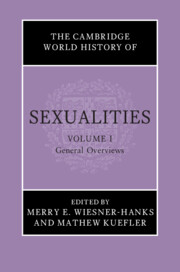Book contents
- The Cambridge World History of Sexualities
- The Cambridge World History of Sexualities
- The Cambridge World History of Sexualities
- Copyright page
- Contents
- Figures in Volume I
- Contributors to Volume I
- Editors’ Preface to the Series
- 1 The History of the History of Sexuality
- 2 The History of Sexuality and Anthropology
- 3 The History of Sexuality and Women’s History
- 4 The History of Sexuality and LGBTQ+ History
- 5 The Impact of Sigmund Freud on the History of Sexuality
- 6 Michel Foucault’s Influence on the History of Sexuality
- 7 Queer Theory and the History of Sexuality
- 8 The Sexual Body in History
- 9 Marriage and Families in the History of Sexuality
- 10 Class in the History of Sexuality
- 11 Sexuality and Race: Representations, Regulations, and Sentiments
- 12 Male Homoerotic Relations in History
- 13 Desire, Love, and Sex between Women in Global History
- 14 Trans and Gender Variant Sexualities in History
- 15 The Sale of Sex in History
- 16 Sexual Violence in History
- 17 Sexual Science in History
- 18 Sexuality and Emotion
- 19 Erotic Art in World History
- 20 Erotic Literature in History
- 21 The Material Culture of the History of Sexuality
- 22 Public History and Sexuality
- Index
- CONTENTS TO VOLUMES II, III, AND IV
- References
7 - Queer Theory and the History of Sexuality
Published online by Cambridge University Press: 26 April 2024
- The Cambridge World History of Sexualities
- The Cambridge World History of Sexualities
- The Cambridge World History of Sexualities
- Copyright page
- Contents
- Figures in Volume I
- Contributors to Volume I
- Editors’ Preface to the Series
- 1 The History of the History of Sexuality
- 2 The History of Sexuality and Anthropology
- 3 The History of Sexuality and Women’s History
- 4 The History of Sexuality and LGBTQ+ History
- 5 The Impact of Sigmund Freud on the History of Sexuality
- 6 Michel Foucault’s Influence on the History of Sexuality
- 7 Queer Theory and the History of Sexuality
- 8 The Sexual Body in History
- 9 Marriage and Families in the History of Sexuality
- 10 Class in the History of Sexuality
- 11 Sexuality and Race: Representations, Regulations, and Sentiments
- 12 Male Homoerotic Relations in History
- 13 Desire, Love, and Sex between Women in Global History
- 14 Trans and Gender Variant Sexualities in History
- 15 The Sale of Sex in History
- 16 Sexual Violence in History
- 17 Sexual Science in History
- 18 Sexuality and Emotion
- 19 Erotic Art in World History
- 20 Erotic Literature in History
- 21 The Material Culture of the History of Sexuality
- 22 Public History and Sexuality
- Index
- CONTENTS TO VOLUMES II, III, AND IV
- References
Summary
This chapter addresses the connections between queer theory and the history of sexuality. The chapter introduces the origins and development of queer theory as an approach that perceives sexuality and gender as constructed and rejects the notion of fixed and stable identities. The chapter addresses queer theory’s adaptation to different geographical locations and questions related to the translation of the term “queer” from one language to another. It continues with discussing the connections and tensions between queer theory and the history of sexuality, and addresses queer perspectives on the archive and the practice of oral history as topics on which the queer theoretical developments have particular relevance for historians. The chapter focuses on two aspects in queer theory, namely the continuities and ruptures in history as well as queer approaches to temporality. The chapter closes with a short reflection on the future possibilities of utilizing queer theory for studies on the history of sexuality. The chapter argues that while queer theory and contemporary research on the history of sexuality already converge in essential points, such as understanding sexuality as socially constructed and the distrust of ahistorical identities, the relationship between these two still holds unexplored opportunities for research.
- Type
- Chapter
- Information
- The Cambridge World History of Sexualities , pp. 137 - 158Publisher: Cambridge University PressPrint publication year: 2024



